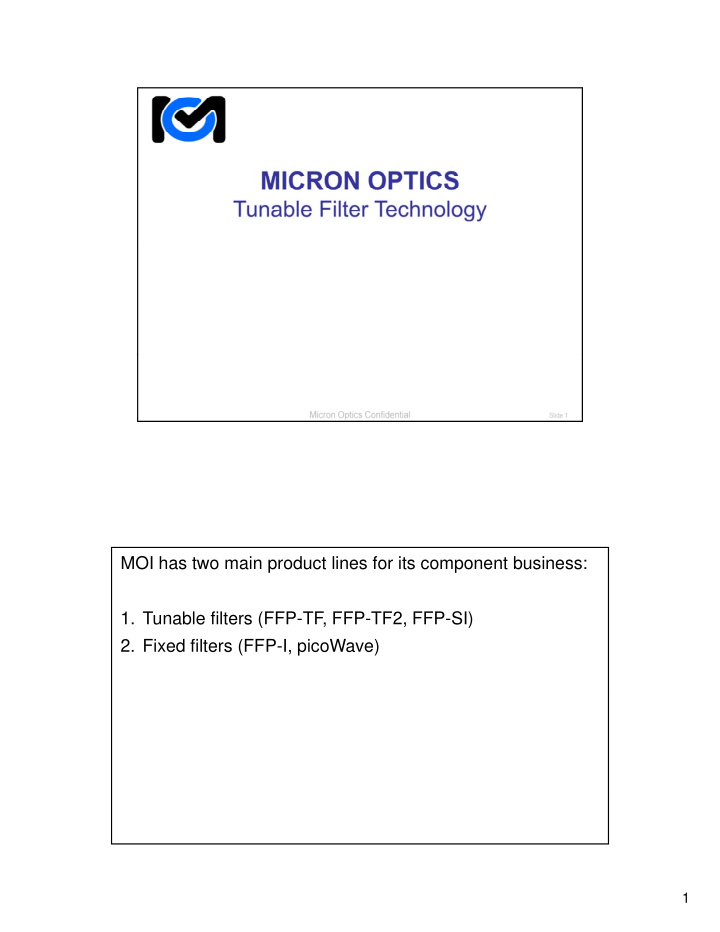



MOI has two main product lines for its component business: 1. Tunable filters (FFP-TF, FFP-TF2, FFP-SI) 2. Fixed filters (FFP-I, picoWave) 1
1. Fiber Fabry-Perot Tunable Filters is MOI’s core technology. 2. MOI can design standard filters that operate from 1260nm to 1640nm and other custom filters with non-telecom wavelengths (i.e.. 850nm, 980nm, and 1060nm) 3. FFP-TF or FFP-TF2 filters can be designed with Finesse (FSR/BW) values up to 16,000. 4 FFP-TF or FFP-TF2 filters can be designed with 4. FFP TF or FFP TF2 filters can be designed with Bandwidth values from 40 MHz to 3,125 GHz. 5. Thousands of filters are currently in the field operating for years in Telecom systems sold by Tier 1 companies (ie. Alcatel, Tellabs, JDSU, Sunrise, OpVista, etc) 2
The table above shows the wide variety of parameters one can customized for their own particular filter application. 3
The maximum amount of continuous optical power that you insert into a filter is inversely proportional to its finesse value (see chart). 4
Here is a cross section of how the original FFP-TF filter design looks. Increasing the voltage to the PZT force the mirrors away from each other thereby increasing the cavity length and shifting the interferometric peaks toward the longer wavelengths. 5
The cross-section view shows how the cavity is comprised mostly of glass with only a small air-gap comprising the remainder. This small air-gap allows for the compression or expansion of the cavity length which results in the filter’s ability to be tuned. 6
This slide shows that the Fiber Fabry-Perot technology is much better than the MEMS solution (shown in graph as the alternative Fabry-Perot technology). 7
In the year 2005, Micron Optics designed a second generation filter called the FFP- TF2. This new design is slightly bigger but has better drift properties than the original FFP-TF design resulting in a more stable performance and lower loss. The original FFP-TF design is still recommended for high speed applications (i.e. OCT). 8
This slide details the benefits of the newer FFP-TF2 design. 9
The specification limits one can select for the FFP-TF2. Notice that the FFP-TF2 is rated for 800Hz operation while the original FFP-TF is rated for 2.5KHz scan rate. 10
Note 1: Other wavelengths (400-1650nm) are available for both TF and TF2 designs. Note 2: Typical value; final value is dependent on Free Spectral Range and Finesse. In general, TF2 losses are less than TF losses with comparable parameters due to improved alignment feature of TF2 design. Note 3: Increasing the voltage for TF filters lengthens the etalon cavity and therefore moves the peaks toward longer wavelengths. Increasing the voltage for TF2 filters shortens the etalon cavity and therefore moves the peaks toward shorter wavelengths. Note 4 Generall Note 4: Generally, for comparable specifications, pricing for the newer FFP-TF2 is for comparable specifications pricing for the ne er FFP TF2 is less than the FFP-TF. Note 5: Filters built with PM fiber are generally 30-50% higher in price due to the difficulty in aligning the 3 optical components (mirror 1, mirror 2, and cavity). Many times, PM mirror availability is limited resulting in NRE fees to cover the design and manufacturer of the special mirrors required. f t f th i l i i d 11
The graphic above details how to build a product code when ordering filters from Micron Optics. 12
1. MOI also provides gas cells as references. p g 2. References are very popular with instrument makers. 13
Some benefits of using a fixed interferometer from Micron Optics. 14
This slides details the wide offerings of specifications for Micron Optics’ fixed filters. 15
Scanning interferometers are tunable filters with free spectral ranges that are 5 GHz or less (long cavity lengths). Very narrow bandwidths can be obtain using this unique design that basically stretches the fiber found inside the cavity to provide tunability. 16
Cross-section of how a FFP-SI (scanning interferometer) is constructed. Applying a voltage to the PZT “stretches” a section of the fiber cavity allowing for tuning. 17
This slides details the specification limits of the FFP-SI. 18
Features and possible applications are listed in this slide. 19
Selection guide for choosing the appropriate design depending on the free spectral range requirement. Note that PM filters are not available in the FFP-TF2 design. 20
Call Micron Optics at 404-325-0005 if you have any questions or need to speak with a technical person about your application. 21
Recommend
More recommend